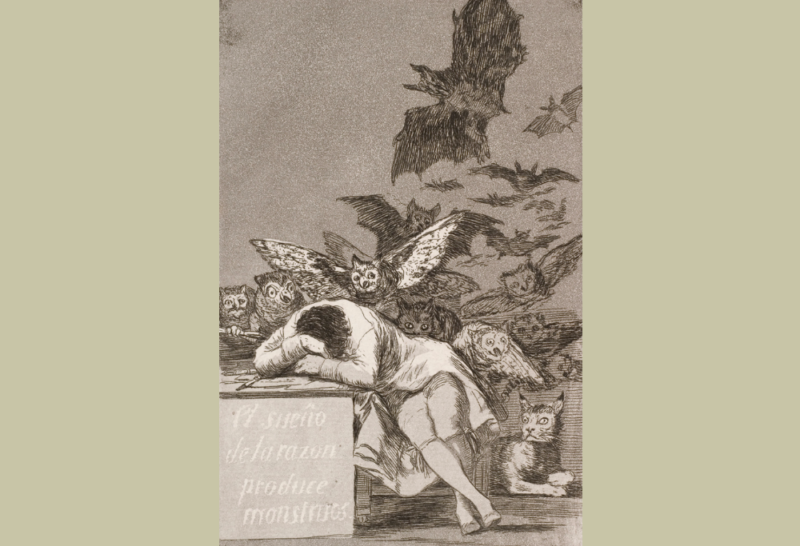El Sueño de la Razón Produce Monstruos is an etching by Francisco de Goya (1746-1828). It was created within -and refers to – the Spanish Enlightenment. According to the usual interpretation of this piece, reason must guide fantasy to produce art; without reason, fantasy produces impossible monsters.
Interestingly, both the image and the text show us otherwise. The title in English is The Sleep of Reason Produces Monsters, but it is occasionally rendered as The Dream of Reason Produces Monsters because the word ‘sueño’ means either ‘sleep’ or ‘dream’ in Spanish. With this in mind we can ask: are the monsters produced when Reason falls asleep? Or rather when Reason dreams, which is, when it reaches its ideal?
Regarding the image, is the man sleeping? Or protecting himself from those animals attacking him? Here we can identify three planes; first, the man at the desk containing the text, then those identifiable animals and, finally, sketched animals in the background. The representation goes beyond its specific historical context to present to us a divided subject, one caught between language and images that lets us glimpse the real.
I find this image a possible depiction of our situation amidst this pandemia. The Age of Reason mutated, becoming this obsession for rational calculation to fulfill one of the many dreams of Modern reason: the eradication of infectious diseases. In this scenario, the COVID-19 emerges as a flash of lightning disturbing the collective dream, not only the one attached to the power of science, but also this other one coming from capitalism regarding unstoppable productivity.
As every time that a crisis emerges, at least two boys cry wolf, again. The first one – the contemporary version of those spiritualists reacting to the spreading of science at all levels of society in the XIXth century- quickly takes the opportunity to declare the arrival of a new era where humans can finally live in harmony due to a “higher level of consciousness”. It is never clear to me how some acts of kindness here and there are enough to believe in such a cuantic jump, in something that is structurally impossible.
The second one – solidly consolidated since the fall of the Berlin Wall – hopes for the end of capitalism but fails to see that every emergence of the real, even though shaking the board, has never been enough to change the rules of the game so far.
But this time we have a new group. In the United States and Canada some people are protesting the ongoing coronavirus-related restrictions and lockdows. They want to immediately reopen the economy. They are desperate to continue dreaming (which in fact is asking for the actual nightmare those restrictions are trying to prevent).
Amidst these demands, I cannot but wonder: what is required to alter this collective dream? How can we, as a society, be more implicated with the monsters we create?

